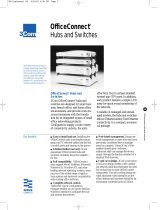
3Com Corporation
■
5400 Bayfront Plaza
■
Santa Clara, California
■
95052-8145
Copyright © 2001 3Com Corporation. All rights reserved. No part of this documentation may be reproduced in any form or by any means or
used to make any derivative work (such as translation, transformation, or adaptation) without written permission from 3Com Corporation.
3Com Corporation reserves the right to revise this documentation and to make changes in content from time to time without obligation on the
part of 3Com Corporation to provide notification of such revision or change.
3Com Corporation provides this documentation without warranty, term, or condition of any kind, either implied or expressed, including, but
not limited to, the implied warranties, terms or conditions of merchantability, satisfactory quality, and fitness for a particular purpose. 3Com
may make improvements or changes in the product(s) and/or the program(s) described in this documentation at any time.
If there is any software on removable media described in this documentation, it is furnished under a license agreement included with the
product as a separate document, in the hard copy documentation, or on the removable media in a directory file named LICENSE.TXT or
!LICENSE.TXT. If you are unable to locate a copy, please contact 3Com and a copy will be provided to you.
UNITED STATES GOVERNMENT LEGEND
If you are a United States government agency, then this documentation and the software described herein are provided to you subject to the following:
All technical data and computer software are commercial in nature and developed solely at private expense. Software is delivered as
“Commercial Computer Software” as defined in DFARS 252.227-7014 (June 1995) or as a “commercial item” as defined in FAR 2.101(a) and
as such is provided with only such rights as are provided in 3Com’s standard commercial license for the Software. Technical data is provided
with limited rights only as provided in DFAR 252.227-7015 (Nov 1995) or FAR 52.227-14 (June 1987), whichever is applicable. You agree not to
remove or deface any portion of any legend provided on any licensed program or documentation contained in, or delivered to you in
conjunction with, this User Guide.
Unless otherwise indicated, 3Com registered trademarks are registered in the United States and may or may not be registered in other countries.
3Com is a registered trademark and the 3Com logo and Dynamic
Access
are trademarks of 3Com Corporation. 3Com Facts is a service mark of
3Com Corporation.
Intel is a registered trademark of Intel Corporation. Novell and NetWare are registered trademarks of Novell, Inc.
Alteon Web Systems, Alteon WebSystems, ACEnic and the A Design Logo are trademarks of Alteon WebSystems, Inc., a wholly owned
subsidiary of Nortel Networks.
All other company and product names may be trademarks of the respective companies with which they are associated.
The software and documentation contained herein are an interim version provided by 3Com Corporation for use with 3Com Gigabit NICs, and
contain ACEnic software earlier released by Alteon WebSystems, Inc. circa Spring 200.
For all Gigabit product questions, contact 3Com Corporation directly at: www.3com.com/promotions/nics/nictransition.html.




















